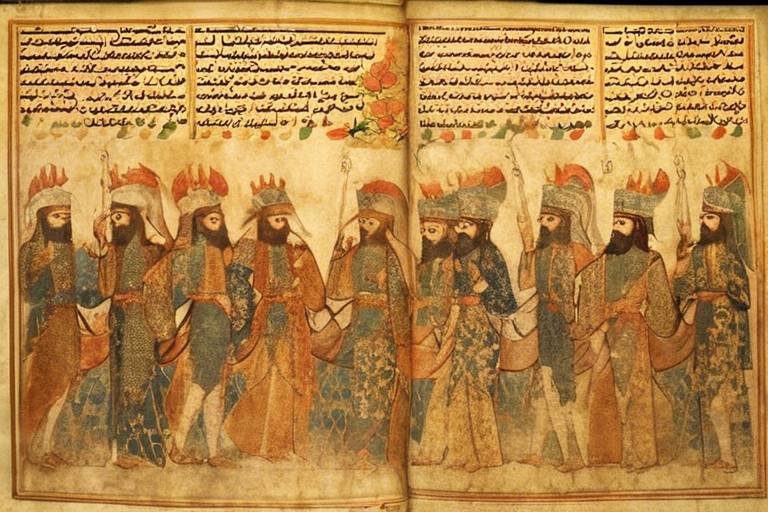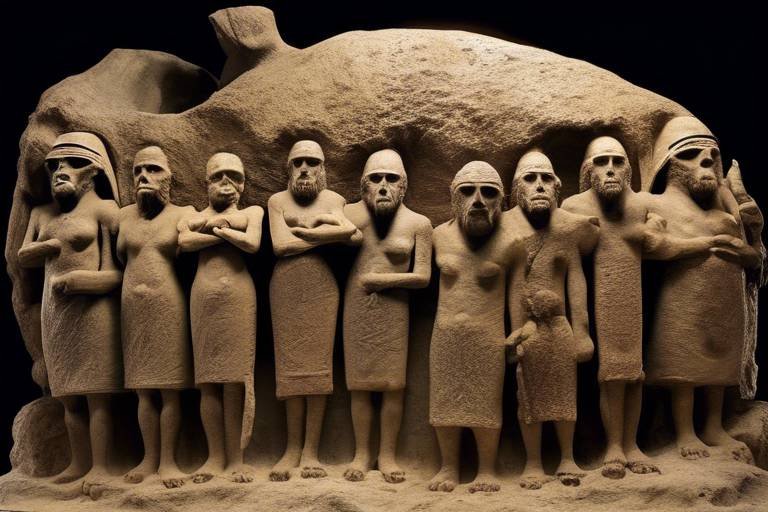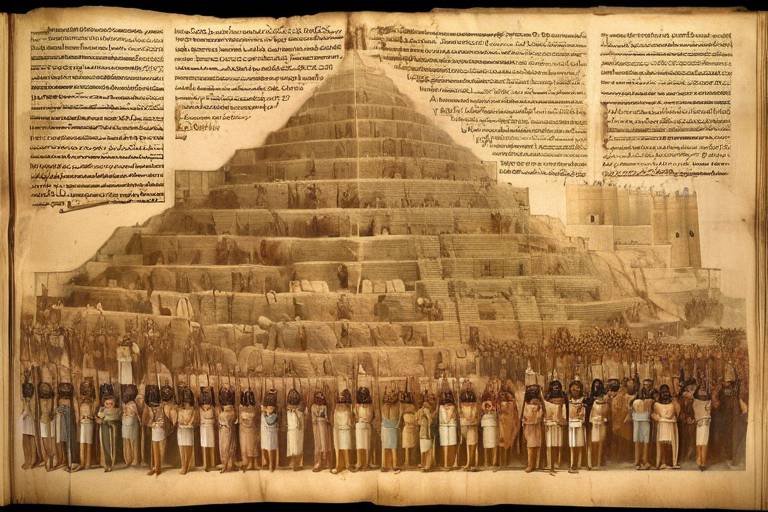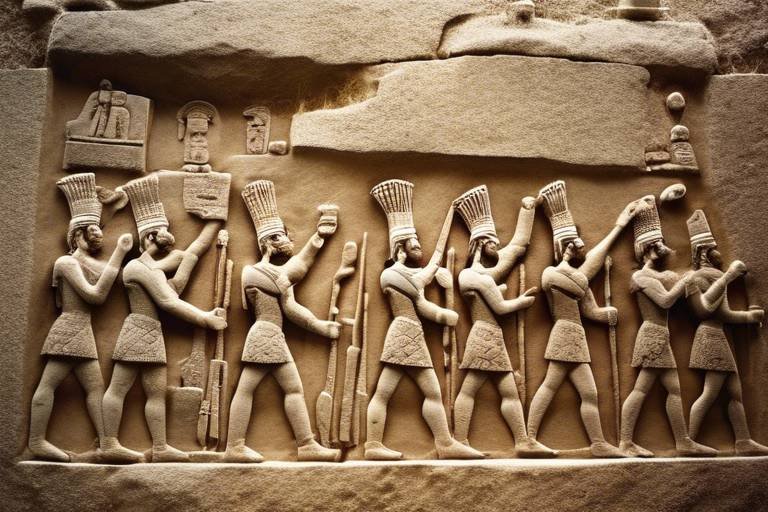The Cultural Dynamics of the Incan Empire
The Incan Empire, a civilization shrouded in mystery and grandeur, was a tapestry woven with diverse cultural threads that shaped its very essence. From the lofty peaks of the Andes to the lush valleys below, the Inca people thrived in an environment where religion, art, architecture, language, social structure, and daily life intertwined to create a rich tapestry of cultural dynamics.
At the heart of the Incan Empire lay a complex web of spiritual beliefs and practices that governed the lives of its people. From the worship of powerful deities like Inti, the sun god, to the performance of elaborate rituals to appease the gods, religion played a central role in shaping the Incan worldview.
The artistic and architectural achievements of the Incas stand as a testament to their ingenuity and creativity. From the intricate textiles and pottery that adorned their daily lives to the awe-inspiring structures of Machu Picchu and Sacsayhuamán, the Incas left behind a legacy of beauty and innovation.
Textiles and pottery were not merely decorative items for the Incas but served as powerful symbols of cultural identity. Through intricate weaving techniques and elaborate pottery designs, the Incas expressed their beliefs, traditions, and stories with every thread and clay mold.
The Incas were master city planners and engineers, creating urban centers that seamlessly blended with the natural landscape. The precision of their construction, exemplified by the marvels of Machu Picchu, showcased their advanced knowledge of engineering and architecture.
Quechua, the language of the Incas, was more than a means of communication; it was a vessel for preserving cultural heritage. Through oral tradition and storytelling, the Incas passed down their history, myths, and legends from generation to generation, ensuring the continuity of their cultural legacy.
Storytelling was a cornerstone of Incan society, with myths and legends woven into the fabric of daily life. Through oral tradition, the Incas imparted wisdom, preserved their history, and fostered a sense of community that transcended time and space.
The Incan society was structured around a rigid social hierarchy that dictated the roles and relationships of its members. From the labor of the common people to the power of the ruling elite, every individual played a vital part in the intricate tapestry of communal life.
In the Incan Empire, gender roles were clearly defined, with men and women each contributing to the cultural dynamics in their own unique ways. While men were often engaged in warfare and agriculture, women played crucial roles in weaving, pottery-making, and maintaining the household.

Religious Practices
Exploring the rich and diverse cultural aspects that shaped the Incan Empire, including religion, art, architecture, language, social structure, and daily life.
Examining the spiritual beliefs, rituals, and deities that were central to the Incan religious system, we delve into a world where the divine intertwined with the earthly. The Incas worshipped a pantheon of gods, each representing different aspects of nature and life. Their religious practices were deeply ingrained in their daily lives, influencing everything from agriculture to governance. Through elaborate ceremonies and offerings, the Incas sought to maintain harmony with the spiritual realm and ensure the prosperity of their empire.
Analyzing the intricate and innovative artistic expressions and architectural marvels of the Incan civilization, we uncover a world where creativity and engineering prowess merged seamlessly. The Incas were master craftsmen, known for their exquisite textiles, intricate pottery, and monumental structures. Their art and architecture not only served functional purposes but also reflected their cultural values and beliefs, leaving a lasting legacy that continues to awe and inspire us today.
Discovering the significance of textiles and pottery in Incan art and their role in expressing cultural identity, we unravel the intricate threads of creativity woven by Incan artisans. Textiles were not merely fabrics but intricate pieces of art, showcasing intricate patterns and vibrant colors that told stories of the Incan way of life. Similarly, pottery was not just utilitarian but a form of artistic expression, with each piece bearing cultural symbols and motifs that connected the past with the present.
Exploring the advanced city planning and engineering feats of the Incas, such as Machu Picchu and Sacsayhuamán, we marvel at the ingenuity and precision of Incan architects and engineers. Their cities were meticulously designed, blending harmoniously with the natural landscape and demonstrating a deep understanding of astronomy and geography. The monumental structures they built, often using massive stone blocks fitted together with astonishing precision, stand as testaments to their engineering prowess and artistic vision.
Investigating the unique language of Quechua and its importance in communication and cultural preservation within the empire, we uncover the linguistic tapestry that bound the diverse Incan territories together. Quechua served as the lingua franca of the empire, enabling communication across different regions and fostering a sense of unity among the Incan people. Through oral tradition and storytelling, the Quechua language played a vital role in preserving Incan history, myths, and cultural heritage for future generations.
Understanding the role of oral tradition and storytelling in passing down Incan history, myths, and legends, we appreciate the power of narratives in shaping collective memory and identity. Through oral recitations and performances, the Incas transmitted their cultural knowledge from one generation to the next, ensuring that their rich heritage and beliefs were not lost to time. Stories of gods, heroes, and ancestors were woven into the fabric of Incan society, connecting past, present, and future in a continuous narrative thread.
Examining the structured social hierarchy and communal lifestyle that defined relationships within the Incan society, we delve into a world where status and solidarity coexisted. The Incas had a complex social structure, with nobles, commoners, and slaves occupying distinct roles in society. Despite these divisions, community life played a central role in Incan culture, with collective labor and shared resources ensuring the well-being of all members. The bonds of kinship and reciprocity formed the foundation of Incan society, fostering a sense of unity and cooperation among its people.
Exploring the distinct roles and responsibilities of men and women in Incan society and how they contributed to the cultural dynamics, we uncover the gendered division of labor that shaped daily life in the empire. While men were primarily involved in activities such as agriculture, warfare, and political leadership, women played crucial roles in domestic duties, textile production, and religious ceremonies. Despite these differences, both men and women held important positions within Incan society, contributing their unique skills and expertise to the cultural tapestry of the empire.

Art and Architecture
Exploring the rich and diverse cultural aspects that shaped the Incan Empire, including religion, art, architecture, language, social structure, and daily life.
When delving into the world of the Incan Empire, one cannot help but be mesmerized by the extraordinary artistic expressions and architectural wonders that defined this ancient civilization. The Incas were masters of blending creativity with functionality, leaving behind a legacy that continues to awe and inspire.
The Incan artistry was not limited to mere aesthetics; it was a reflection of their beliefs, traditions, and way of life. Intricate textiles and pottery served as canvases through which they conveyed their cultural identity and stories. Each pattern, each design, carried a deeper meaning, weaving a tapestry of history and symbolism.
Moreover, the architectural prowess of the Incas is evident in the magnificent structures they built, such as the legendary Machu Picchu and the formidable Sacsayhuamán. These engineering marvels stand as testaments to their advanced city planning and construction techniques, showcasing a harmonious blend of innovation and reverence for the natural landscape.
Incan architecture was not merely about erecting buildings; it was about creating living spaces that harmonized with the environment and served both practical and spiritual purposes. The precision with which they aligned their structures with celestial events speaks volumes about their astronomical knowledge and spiritual connection to the cosmos.
Through their art and architecture, the Incas communicated not only with each other but also with the gods and the spirits of their ancestors. Every stroke of the brush, every stone laid in place, was a tribute to their beliefs and a means of preserving their cultural heritage for generations to come.
- What role did art play in Incan society?
- How did the Incas incorporate astronomy into their architecture?
- What are some notable examples of Incan architecture?
- What materials were commonly used in Incan art and architecture?
Art in the Incan Empire was not just for aesthetic purposes; it served as a medium for storytelling, cultural expression, and religious symbolism.
The Incas aligned their structures with celestial events to honor their gods and mark important dates in their calendar, showcasing their advanced knowledge of astronomy.
Iconic structures like Machu Picchu, Sacsayhuamán, and Ollantaytambo stand as enduring testaments to the architectural genius of the Incas.
Textiles, pottery, and stones like granite were prevalent in Incan art and construction, reflecting their resourcefulness and craftsmanship.

Textiles and Pottery
Textiles and pottery played a crucial role in the artistic and cultural expression of the Incan civilization. The Incas were highly skilled in weaving intricate textiles using various materials such as alpaca and llama wool. These textiles were not only used for clothing but also as a form of communication, with different patterns and colors representing different meanings and social status. Additionally, pottery was another essential artistic medium for the Incas, with pottery vessels serving both practical and ceremonial purposes. The intricate designs and motifs on Incan pottery reflected their beliefs, stories, and daily life, providing a glimpse into their rich cultural heritage.
**Frequently Asked Questions:** 1. **What were the main materials used in Incan textile production?** - The main materials used in Incan textile production were alpaca and llama wool, known for their softness and durability. 2. **How did textiles play a role in social status within Incan society?** - Textiles were used as a form of communication, with different patterns and colors symbolizing social status and roles within the community. 3. **What significance did pottery hold in Incan culture?** - Pottery was not only used for practical purposes but also played a significant role in ceremonial and artistic expressions, showcasing intricate designs and motifs. 4. **Were there specific symbols or motifs commonly found in Incan pottery?** - Yes, Incan pottery often featured symbols related to nature, animals, and religious beliefs, reflecting their connection to the spiritual world.
City Planning and Engineering
The Incan Empire is renowned for its remarkable city planning and engineering achievements that continue to captivate modern-day observers. The strategic layout of cities and the intricate engineering prowess displayed by the Incas exemplify their advanced understanding of urban design and construction techniques. One of the most iconic examples of their architectural ingenuity is the awe-inspiring citadel of Machu Picchu, perched high in the Andes mountains with its terraced fields and intricate stone structures blending harmoniously with the natural landscape.
Furthermore, the massive stone walls of Sacsayhuamán stand as a testament to the Incan mastery of precision stonework and monumental construction. The intricate fitting of enormous stones without the use of mortar showcases their engineering precision and architectural sophistication. The megalithic stones, some weighing over 100 tons, were transported from quarries miles away and fitted together with such precision that not even a blade of grass could pass between them.
The Incan city planning was meticulously organized, with streets, plazas, and buildings designed to align with celestial events and natural topography. This cosmic alignment not only reflected their spiritual beliefs but also served practical purposes, such as agricultural planning and water management. The Incas ingeniously utilized terraces, aqueducts, and irrigation systems to maximize agricultural productivity in the challenging Andean terrain.
Moreover, the Incan road network, known as the Qhapaq Ñan, spanned thousands of miles across diverse landscapes, connecting distant regions of the empire and facilitating communication, trade, and military expeditions. These roads were meticulously constructed, often carved into mountainsides or paved with stones, showcasing the Incan expertise in engineering and logistics.

Language and Communication
Exploring the rich and diverse cultural aspects that shaped the Incan Empire, including religion, art, architecture, language, social structure, and daily life.
Examining the spiritual beliefs, rituals, and deities that were central to the Incan religious system.
Analyzing the intricate and innovative artistic expressions and architectural marvels of the Incan civilization.
Discovering the significance of textiles and pottery in Incan art and their role in expressing cultural identity.
Exploring the advanced city planning and engineering feats of the Incas, such as Machu Picchu and Sacsayhuamán.
Investigating the unique language of Quechua and its importance in communication and cultural preservation within the empire.
Understanding the role of oral tradition and storytelling in passing down Incan history, myths, and legends.
Examining the structured social hierarchy and communal lifestyle that defined relationships within the Incan society.
Exploring the distinct roles and responsibilities of men and women in Incan society and how they contributed to the cultural dynamics.

Oral Tradition and Storytelling
Oral tradition and storytelling played a pivotal role in the cultural tapestry of the Incan Empire, serving as the primary method of passing down history, myths, and legends from generation to generation. The Inca civilization relied heavily on spoken narratives to preserve their rich heritage and ensure that their collective memory endured through time.
Through the art of storytelling, the Incas wove intricate tales that not only entertained but also imparted valuable lessons and insights into their beliefs and customs. These stories were often shared during communal gatherings, where individuals of all ages would come together to listen, learn, and connect with their shared past.
Moreover, oral tradition served as a means of reinforcing social norms, values, and cultural practices within Incan society. By recounting myths and legends orally, the Incas reinforced the importance of collective identity and instilled a sense of unity among community members.
Furthermore, storytelling was a dynamic form of communication that allowed for the adaptation and evolution of narratives over time. Through oral retellings, stories could be embellished, modified, or reinterpreted to resonate with contemporary audiences while retaining their core essence.
In essence, oral tradition and storytelling were not merely forms of entertainment for the Inca people but rather vital conduits through which their cultural heritage was preserved, shared, and celebrated across generations.

Social Hierarchy and Community Life
The Incan society was intricately structured, with a clear social hierarchy that dictated roles and relationships within the community. At the pinnacle of the hierarchy was the Sapa Inca, the emperor, who was considered divine and held absolute power over the empire. Below the Sapa Inca were the nobles, who held significant political and administrative positions. These nobles enjoyed privileges such as land ownership and access to luxury goods.
Further down the hierarchy were the commoners, who made up the majority of the population. Commoners were primarily farmers and artisans, contributing to the empire's economy and infrastructure. Despite their lower status, commoners played a crucial role in sustaining the empire through their labor.
Community life in the Incan Empire was characterized by a collective ethos, where individuals prioritized the well-being of the community over personal interests. This communal lifestyle was fostered by the concept of ayllu, a kinship-based community structure where families lived and worked together, sharing resources and responsibilities.
Within the ayllus, individuals had defined roles and duties based on age and gender. Men were typically responsible for agricultural work and defense, while women managed household tasks and textile production. Despite these gender-specific roles, both men and women were valued for their contributions to the community.
The Incan society placed a strong emphasis on reciprocity and mutual support, with community members coming together to address common challenges and celebrate important events. Festivals, ceremonies, and communal labor projects were integral parts of community life, reinforcing social bonds and cultural identity.

Roles of Men and Women
In the Incan society, the roles of men and women were clearly defined and played crucial parts in the cultural dynamics of the empire. Men were primarily responsible for tasks such as hunting, warfare, and construction, showcasing their physical strength and providing for their families. They were also involved in political and religious affairs, holding positions of power and leadership within the community. On the other hand, women took on roles centered around domestic duties, agriculture, and textile production. They were skilled weavers, creating intricate textiles that were highly valued in Incan society. Additionally, women played essential roles in nurturing children, maintaining households, and preserving cultural traditions through oral storytelling.
Despite the distinct division of labor based on gender, both men and women were respected for their contributions to the community. While men held positions of authority in public spheres, women wielded influence within the private domain, shaping family dynamics and passing down cultural knowledge to future generations. The complementary roles of men and women in Incan society reflected a balance of responsibilities that sustained the social structure and contributed to the overall cohesion of the empire.
Frequently Asked Questions
- What were the main religious beliefs of the Incas?
The Incas worshipped a variety of deities, with the sun god Inti being the most important. They believed in the concept of ancestor worship and performed elaborate rituals to honor their gods.
- How did the Incas express their cultural identity through art?
The Incas were skilled in textiles and pottery, using intricate designs and vibrant colors to convey their cultural heritage. Their art often depicted scenes from daily life, nature, and religious beliefs.
- What were the key architectural achievements of the Incan Empire?
The Incas are renowned for their impressive city planning and engineering skills, as seen in structures like Machu Picchu and Sacsayhuamán. Their buildings were constructed with precision and durability, showcasing their advanced knowledge of construction techniques.
- How did Quechua language contribute to the cultural preservation of the Incas?
Quechua was the official language of the Incas and played a crucial role in communication and preserving their cultural heritage. It was used in oral tradition, storytelling, and passing down historical accounts from generation to generation.
- What were the social roles of men and women in Incan society?
In Incan society, men and women had distinct roles and responsibilities. Men were primarily involved in hunting, warfare, and political leadership, while women were responsible for domestic tasks, agriculture, and textile production.



















